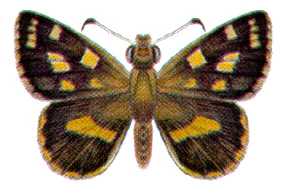
Gahnia is a genus of sedges native to China, Southeast Asia, New Guinea, Australia, New Zealand and a number of Pacific Islands. The common name is due to the toothed margins. It often forms tussocks.

Gahnia filum, the chaffy saw-sedge, is a tussock-forming perennial in the family Cyperaceae, endemic to Australia. It grows to between 60 and 110 cm in height.
Gahnia trifida, the coastal saw-sedge, is a tussock-forming perennial in the family Cyperaceae, endemic to southern Australia.

Antipodia chaostola, the chaostola skipper, is a butterfly of the family Hesperiidae. It is found in Australia along the coast of Victoria, New South Wales and Tasmania.

Hesperilla chrysotricha, the chrysotricha skipper or goldenhaired sedge-skipper, is a butterfly of the family Hesperiidae. It is found in the Australian states of Victoria, Tasmania, South Australia and Western Australia.

Hesperilla crypsargyra, the silvered skipper or silver hedge-skipper, is a butterfly of the family Hesperiidae. It is found in the Australian states of New South Wales, Queensland and Victoria.

Hesperilla donnysa, the donnysa skipper or varied sedge skipper, is a butterfly of the family Hesperiidae. It is found in the Australian Capital Territory, New South Wales, Queensland, South Australia, Tasmania, Victoria and Western Australia.

Hesperilla idothea, the flame sedge-skipper, is a butterfly of the family Hesperiidae. It is found in the Australian states of New South Wales, Queensland, South Australia and Victoria.

Hesperilla ornata, the spotted skipper or spotted sedge-skipper, is a butterfly of the family Hesperiidae. It is found along the non-tropical eastern seaboard of mainland Australia and in the adjacent mountain ranges.

Gahnia grandis is a tussock-forming perennial plant found in southeastern mainland Australia and Tasmania.

Gahnia sieberiana, commonly known as the red-fruit saw-sedge, is a tussock-forming perennial plant in the family Cyperaceae, endemic to Australia. It is a widespread plant that favours damp sunny sites. Many insect larvae have been recorded feeding on the red-fruit saw-sedge. It may grow over 2 metres tall.
Gahnia howeana is a flowering plant in the sedge family. The specific epithet refers to Lord Howe Island, where it is found. It was formerly lumped with Gahnia xanthocarpa, which is now considered to be endemic to New Zealand.
Lake Hawdon South Conservation Park is a protected area located in the Australian state of South Australia in the locality of Bray about 280 kilometres (170 mi) south-east of the state capital of Adelaide and about 18 kilometres (11 mi) east of the town of Robe.
Ichneutica theobroma is a moth of the family Noctuidae. This species is endemic to New Zealand. The males of this species has a pink chocolate brown appearance to its forewings with a small white dot. The males of this species can be distinguished from the 'northern dark form' of Ichneutica arotis as they have broader shaped forewings with less markings than the latter species. The females are extremely difficult if not impossible to tell apart. I. theobroma are found in the northern parts of the North Island and inhabit kauri forests. The life history of this species is unknown as are the host species of its larvae although it has been hypothesised that larval hosts include Gahnia setifolia and Gahnia xanthocarpa. Adults of this species are on the wing from mid September until early November and are attracted to light.
Gahnia sclerioides is a tussock-forming perennial in the family Cyperaceae, that is native to south western parts of Western Australia.
Gahnia halmaturina is a tussock-forming perennial in the family Cyperaceae, that is native to parts of South Australia.
Gahnia hystrix is a tussock-forming perennial in the family Cyperaceae, that is native to parts of Kangaroo Island.

Gahnia microstachya is a tussock-forming perennial in the family Cyperaceae, that is native to south eastern parts of Australia from New South Wales to Tasmania.
Gahnia javanica is a tussock-forming perennial in the family Cyperaceae, that is native to parts of Asia and Melanesia.
Gahnia vitiensis is a tussock-forming perennial in the family Cyperaceae, that is native to Fiji and Hawaii.











